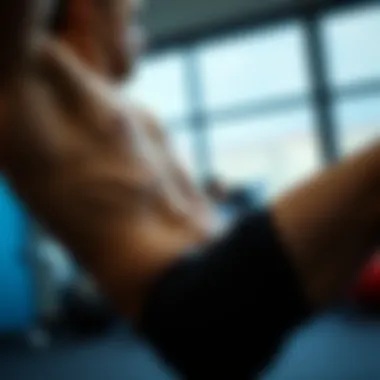Effective Exercises to Tighten Stomach Skin


Intro
When it comes to skin elasticity, the stomach region often takes center stage in discussions about fitness and body composition. As we navigate through life, various factors—be it age, weight fluctuations, or even pregnancy—can take a toll on the skin's firmness. If you're reading this, you might be wondering how to reclaim that tight and toned appearance in your midsection. The good news is that through a blend of targeted exercises and sensible dietary choices, it's quite achievable.
In this guide, we'll explore exercises specifically tailored to tighten stomach skin, while also considering broader wellness strategies that can help improve your overall health. We will separate the wheat from the chaff and dig into what really works, focusing on evidence-based practices that professionals in health and wellness consistently advocate. Expect a mix of workouts, nutritional advice, wellness insights, and even a peek into the latest trends. Let's dive into ways to enhance not just the appearance of your stomach skin, but your entire sense of well-being.
Understanding Abdominal Skin Elasticity
When aiming for tighter skin around the stomach, grasping the concept of skin elasticity becomes crucial. This understanding helps in devising practical approaches that blend exercise, nutrition, and lifestyle choices effectively. Skin elasticity refers to the skin's ability to stretch and then return to its original shape. This quality serves as a foundation for skin tightness, particularly in the abdominal area, where changes in body composition often occur due to weight fluctuations, pregnancy, or aging. Understanding these facets can lead to more informed decisions regarding fitness and health routines.
The Biology of Skin Elasticity
Skin elasticity is largely dictated by the presence of elastin and collagen, two proteins that function like the framework of a building. Elastin allows the skin to stretch, while collagen provides strength and structure. Over time, factors like age, exposure to UV rays, and hormonal changes can diminish these proteins, leading to sag or crepe-like appearance. Moreover, if someone has undergone significant weight loss, the skin may not retract fully, which might be disheartening for many. Keeping this biological perspective in mind paves the way for understanding why some individuals might find their skin less resilient than others. Maintaining a routine that aims to stimulate collagen and elastin production becomes essential in addressing these changes.
Factors Affecting Skin Tightness
The journey toward tighter stomach skin is influenced by several interconnected factors:
- Age: As one gets older, the skin’s natural elasticity diminishes due to decreased collagen and elastin production.
- Weight Changes: Rapid gain or loss of weight can stretch the skin beyond its elastic capacity, often resulting in sagging.
- Genetics: Some people may have a genetic predisposition to thinner skin or slower collagen production, making it harder to achieve tight skin.
- Hormonal Fluctuations: Hormones play a significant role, especially during periods like pregnancy or menopause, where the dynamics of skin elasticity can change drastically.
Understanding these factors helps in customizing approaches that are more fit for personal well-being and fitness goals. By considering specific lifestyle adjustments or targeted exercises, you can promote skin elasticity and improve overall appearance in the abdominal area.
The Role of Hydration in Skin Health
Hydration serves as the unsung hero in the quest for skin tightness. Skin hydration impacts its texture, elasticity, and appearance. When the body is well-hydrated, skin cells can retain their optimal structure, helping to maintain firmness. Conversely, dehydration can lead to dry, flaky skin, making it more prone to sag and wrinkles. Moreover, adequate hydration aids in flushing out toxins and transporting essential nutrients to skin cells. Recommendations for maintaining hydration include:
- Drinking Water: Aim to consume at least eight 8-ounce glasses of water daily, adjusting based on activity levels and environmental factors.
- Hydrating Foods: Incorporate fruits and vegetables like cucumbers, oranges, and lettuce, which contribute to your daily hydration needs.
- Limit Caffeine and Alcohol: These substances can be diuretics, which may lead to dehydration if consumed excessively.
In summary, grasping the science behind abdominal skin elasticity lays the groundwork for a holistic approach to skin tightening. With the right mix of exercises, adequate hydration, and an understanding of personal variables, achieving tighter stomach skin becomes a more attainable goal.
Exercise Types for Tightening Abdominal Skin
Understanding the different exercise types is crucial in addressing the unique needs of abdominal skin tightening. The body’s appearance, especially in the midsection, can often showcase the effects of aging, weight loss, or even lifestyle choices. By integrating the right exercises into your routine, one can significantly improve skin elasticity and muscle tone in the abdominal area. Not only does exercise lead to improved aesthetics, but it also leans into the overall health benefits that come with increased physical activity and enhanced body awareness.
Resistance Training
Resistance training is pivotal in skin tightening and muscle building. It assists in creating lean muscle mass, which can help fill out the skin and give it a firmer appearance. The increasing strength and definition can serve as a practical tool for combatting the loosening of skin that often accompanies weight fluctuations.
Benefits of Strength Training
Strength training noticeably boosts metabolism, allowing the body to burn calories more efficiently, even at rest. This can be a huge plus if you are looking to maintain a healthy weight or shed a few pounds. By building muscle, you are also positively impacting the production of collagen, a protein that plays a fundamental role in helping the skin retain its elasticity.
Moreover, strength training promotes better posture and core stability. It is well-acknowledged that a solid core provides not just bodily benefits but also aids in reducing back pain, improving overall quality of life. This multifaceted advantage makes strength training a favored approach for many, especially in reference to abdominal concerns.
Recommended Resistance Exercises
Starting with exercises such as planks, squats, or even bench presses can create a foundation for muscle engagement across various areas of the body, specifically around the core. Incorporating variations like weighted Russian twists or cable crunches can enhance direct engagement with the abdominal muscles, facilitating muscle growth and tightening skin.
These exercises target not just the superficial muscles, but also engage the deeper layers, offering comprehensive toning. However, one must keep in mind that while resistance exercises are beneficial, they should be part of a balanced regimen that includes other forms of workout for best results.
Proper Form and Technique
Understanding proper form during resistance training is non-negotiable. Poor technique can lead to injuries or unwanted strains, particularly in the abdominal area where stability is key. This means maintaining a neutral spine, engaging your core, and ensuring you control your movements throughout each exercise.
Correct form enhances effectiveness, promoting not only strength gains but also ensures that the resistance exercises are working the intended muscle groups.
Aerobic Exercise
Aerobic exercises, or cardiovascular activities, play a critical role in any fitness plan aimed at tightening stomach skin. They assist in body fat loss, making them complementary to strength training.
Types of Effective Aerobic Activities
Engaging in activities like running, cycling, swimming, or even brisk walking can provide efficient cardiovascular benefits. These exercises elevate heart rate, increase arterial blood flow, and help reduce overall body fat, which is integral in tightening skin. Each of these activities can be tailored to various fitness levels making them accessible and versatile.
In addition, group classes such as Zumba or spin classes can stimulate muscle movement while keeping it enjoyable and social, which can be a motivating factor for many participants.
Duration and Intensity Guidelines
To derive benefits from aerobic exercise, aiming for at least 150 minutes of moderate-intensity or 75 minutes of high-intensity exercise each week is generally advisable. The key is consistency and gradually increasing the intensity as fitness levels improve. Finding a sustainable rhythm is often more effective than short bursts of high activity followed by extended periods of inactivity.
Impact on Body Composition


The influence of aerobic exercise on body composition cannot be understated. When coupled with resistance training, it helps create a calorie deficit, essential for weight management. Furthermore, regular participation can lead to enhanced cardiovascular health, which is linked to better skin health overall.
Core-Specific Workouts
Focusing on the core is fundamental when tightening stomach skin. Not only does a strong core improve aesthetics, but it also supports back health and posture.
Importance of Core Strength
Core strength is vital in providing stability and balance, which translates to better performance in both daily activities and exercise routines. For many people, a strong core serves as a foundational aspect that enhances the overall effectiveness of workouts across various domains.
Moreover, as the abdominal muscles are engaged more effectively, it leads to increased functionality. During any movement, whether it is lifting groceries or exercising, the core’s strength provides support and contributes to injury prevention.
Targeted Core Exercises
Incorporating specifically targeted exercises such as crunches, leg raises, or stability ball exercises into your routine can enhance the intensity and effectiveness of core workouts. These exercises directly engage the abdominal muscles, potentially improving muscle definition and skin firmness.
Each exercise can be modified to fit your fitness level and goals, making them flexible options for individuals looking to boost their core.
Integrating Core Work with Other Routines
Integrating core workouts into broader exercise routines is highly beneficial. For example, performing core exercises during strength training warm-ups or integrating them into cardiovascular training can keep the body engaged while ensuring that all muscle groups are worked effectively.
Thus, amalgamating core-specific workouts into a diverse training regime provides comprehensive development for a stronger and more toned appearance, reinforcing the principles of holistic wellness.
"A robust core is the root of a strong body; it not only shapes you aesthetically but also provides foundational strength and stability."
By diversifying your exercise regimen to include resistance training, aerobic activities, and core-specific workouts, you pave the way for enhanced abdominal strength and skin tightening, supporting the ultimate goal of improved body confidence and health.
Integrating Flexibility and Mobility Training
When talking about enhancing abdominal skin tightness, it's easy to overlook the critical role that flexibility and mobility training plays. While resistance workouts and aerobic exercises are always in the spotlight, flexibility training deserves its fair share of attention. Engaging in regular flexibility routines does more than just make you more limber; it enhances movement efficiency and supports overall muscle health. In fact, increased flexibility could lead to improved posture, less strain on muscles, and a better ability to perform various exercises, contributing significantly to skin tightness and tone.
The Importance of Flexibility
Flexibility is vital for anyone looking to improve their physical health. When muscles are flexible, they can work more effectively. Think of it this way: a well-oiled machine works better than one that’s rusty and stiff. Similarly, flexible muscles can help protect against injuries, especially during high-intensity workouts aimed at tightening the skin around the stomach area. This physical agility allows for a broader range of movements, so you can get deeper into your workouts and maximize the benefits.
Staying flexible also contributes to blood flow, which is crucial for skin health. Enhanced circulation helps deliver essential nutrients right where they're needed most, preserving skin elasticity and health. Additionally, maintaining flexibility in the abdominal region can alleviate tension that builds up, especially if you spend long hours sitting or performing repetitive tasks.
Yoga and Pilates for Skin Tightening
Yoga and Pilates are two excellent practices that merge flexibility with strength training, making them ideal for improving abdominal skin tone. Both disciplines engage the core and enhance flexibility, aiding in tightening skin over time. They offer more than just physical benefits; they also promote mental well-being, which can boost your motivation to maintain an active lifestyle.
Specific Poses for Core Engagement
Certain yoga and Pilates poses focus specifically on core engagement, which plays a significant role in tightening stomach skin. Take the plank pose, for example. This simple yet effective position helps build strength across multiple muscle groups, including the core. The beauty of this pose lies in its ability to engage not just the superficial abdominal muscles but also the deeper layers, supporting better overall tone.
Additionally, poses like the Boat Pose in yoga or the Hundred in Pilates directly target the core and involve controlled movements. These exercises teach you to engage your core consciously, allowing you to activate those muscles that are often put to the back burner. Over time, this consistent activation can lead to improvements in skin firmness.
Breath Control and Relaxation Benefits
Breath control is an often-overlooked aspect of flexibility training. In practices like yoga, mastering breath can aid in relaxation and improve focus during workouts. Conscious breath work not only enhances performance but also contributes to reducing stress levels. Stress can wreak havoc on the skin, leading to various issues including loss of elasticity. Consequently, managing breath during exercises helps facilitate a deeper connection with the body, making every movement more effective and potentially resulting in better skin health.
Adopting techniques like diaphragmatic breathing enhances oxygen delivery to the tissues, fostering better nutrient absorption. This internal boost directly impacts skin elasticity as well. Remember that finding this inner peace and control is just as critical as the physical exercises themselves.
Scheduling Flexibility Sessions
Incorporating flexibility training into your routine may seem daunting, but it's all about how you schedule it. Often, folks associate stretching with after a workout, but carving out dedicated times for flexibility is essential. Short, focused sessions involving yoga or Pilates can be surprisingly effective to engage the muscles without overdoing it.
Consider setting aside a few minutes every day or a couple of times a week specifically for flexibility training. This dedicated time can improve not only your physical capabilities but also your mental approach to workouts. Emphasizing flexibility should be part of your overall strategy, woven into the fabric of your fitness journey rather than an afterthought.
By prioritizing flexibility, you aid in maintaining vascular health and support recovery, both of which are imperative for achieving progress towards healthier skin on your stomach.
"Flexibility is the key to stability."
– John Wooden
In essence, integrating flexibility and mobility training into your regimen reaps benefits transcending mere aesthetics. It’s a fundamental pillar that rounds out the journey toward tighter stomach skin, enhancing overall physical health in the process.
Nutritional Considerations for Skin Tightening
When discussing how to tighten stomach skin, nutrition plays a critical role. It’s not just about the exercises you do; what you put in your body shapes your skin’s elasticity and overall health. Many individuals overlook how essential nutrients and hydration can bolster skin appearance. This section dives deep into the building blocks of skin health, allowing you to forge a winning strategy for tightening that abdominal skin.
Essential Nutrients for Skin Health


Vitamins and Minerals to Focus On
Vitamins and minerals are the unsung heroes of skin health. Particularly, vitamin C and vitamin E stand out as vital nutrients. Vitamin C supports collagen synthesis, a protein that provides structure to your skin. This vitamin also acts as an antioxidant, protecting against skin damage. On the other hand, vitamin E aids in skin repair, working in tandem with vitamin C to combat oxidative stress.
The unique feature here is their synergistic effect; when consumed together in foods like oranges and almonds, they enhance the skin’s ability to retain moisture, thus improving elasticity. A daily intake of these vitamins can be a game-changer for those eager to tighten their stomach skin.
Hydration's Role
Hydration is often underestimated but is instrumental in skin tightening. When your body is well-hydrated, skin remains plump and vibrant. Proper water intake helps to maintain skin elasticity and health. Not only does it flush out toxins, but it also helps to deliver necessary nutrients to skin cells.
Think of water as the foundation of your skin’s structure. Without sufficient hydration, skin can lose its firmness and start to sag. As a simple tip, aim for at least eight glasses of water a day. During workouts, increase water intake to combat fluid loss and sustain skin integrity.
Foods that Promote Elasticity
Incorporating certain foods into your diet can notably enhance skin elasticity. Foods rich in omega-3 fatty acids—like salmon, walnuts, and flaxseeds—are fantastic choices because they help to strengthen cell membranes and remove toxins. Additionally, leafy greens support skin health through various vitamins; spinach, for instance, is rich in iron and vitamin K, which assists in overall skin repair and growth.
Unique to skin health is the discovery that antioxidants found in berries can combat free radicals, which contributes to skin aging. Eating a variety of colorful fruits and vegetables ensures your skin gets a range of nutrients crucial for its elasticity and resilience.
Managing Body Composition through Nutrition
Caloric Deficit for Fat Loss
Understanding the caloric deficit is vital for anyone looking to tighten their stomach skin. When you consume fewer calories than you burn, your body begins to utilize stored fat for energy. This process not only supports weight loss but can also lead to improved skin tightness by reducing excess fat that may be distending the skin.
The key characteristic here is in how the body redistributes fat when it is consistently in a caloric deficit. However, it’s crucial to strike a balance—excessively low caloric intake can deprive your skin of essential nutrients, potentially leading to a dull complexion.
Protein’s Role in Muscle and Skin Repair
Protein plays a fundamental role in muscle and skin repair, working on a cellular level to rejuvenate skin after it’s been stretched or sagged from weight fluctuations. Building muscle can also help fill out loose skin through hypertrophy, adding another layer of support beneath the surface.
Focusing on lean protein sources—such as chicken, beans, and Greek yogurt—will provide you with the amino acids needed for collagen production and skin maintenance.
Balanced Diet Tips
A balanced diet is your best shot for tight stomach skin. Ensure that every meal includes a healthy balance of macronutrients—proteins, carbohydrates, and fats. Avoid excessive sugar and processed foods, as they can lead to inflammation and skin damage.
Some practical tips include:
- Encourage whole food sources rather than processed options.
- Focus on portion control to maintain a steady caloric intake.
- Experiment with meal prepping to include a rainbow of fruits and veggies daily.
Remember, what you put into your body fuels your journey toward tighter, healthier stomach skin. Make it count!
Lifestyle Factors Influencing Skin Appearance
Understanding how various lifestyle factors affect skin health, particularly the appearance of abdominal skin, can’t be overstated. It’s more than just exercises keeping the muscles firm; a holistic approach also looks at the daily habits you cultivate. With the right adjustments in lifestyle, you can support your body’s natural ability to tighten and rejuvenate your skin, leading to a healthier, firmer appearance.
The Effects of Sleep on Skin Health
Sleep often takes the back seat in today’s fast-paced world, yet it's crucial for skin health. During deep sleep, your body goes into repair mode, producing growth hormones that aid in regeneration of both muscle and skin cells. It’s like your skin gets a mini spa treatment nightly! Poor sleep, on the other hand, can lead to dullness, puffiness, and a sagging appearance. Aim for 7-9 hours of quality sleep per night.
Prioritizing restful sleep can drastically improve your skin health—resilience and elasticity often hinge upon it.
Establish a soothing bedtime routine, avoid screens for at least an hour before bed, and create an environment that's cool and dark. Consider these habits as investments in your skin's future.
Stress Management Techniques
Stress does more than weigh heavily on your mind; it impacts your physical appearance, particularly your skin. Elevated stress levels increase cortisol production, which can weaken skin integrity over time. To combat this, employing effective stress management techniques is essential. Engaging in activities like meditation, mindfulness, and physical exercises enhances relaxation and promotes a clearer mind.
Consider adding the following strategies to your daily routine:
- Mindful breathing: Practices like deep breathing exercises or meditation can lower stress significantly.
- Nature walks: Spending time outdoors has a calming effect and can brighten your mood while benefiting your skin.
- Structured fitness plans: Regular exercise reduces tension and stimulates blood flow, which is vital for nutrient delivery to skin cells.
Making room for activities that foster relaxation can create significant benefits for overall skin quality.
Avoiding Harmful Habits
To achieve healthy skin, it’s essential to sidestep habits that cause more harm than good. Here are three critical areas worth exploring:
Impact of Smoking
Smoking brings a host of detrimental effects to the skin. The chemicals in cigarettes constrict blood vessels, which deprives skin of necessary oxygen and nutrients. This can manifest as premature aging, fine lines, and a dull complexion. Additionally, the repetitive facial movements associated with smoking can cause wrinkles around the mouth.


Giving up smoking is often the best investment you can make for your skin’s future. It’s a transformative choice, and with the right support, many have navigated this tough journey successfully.
Limitations on Alcohol Intake
Consuming alcohol in moderation is key. While it may seem social and harmless, alcohol can lead to dehydration—a major enemy of skin elasticity. It often disrupts sleep patterns and increases cortisol levels, both of which are vital for maintaining vibrant skin. Limiting alcohol intake not only improves hydration levels but helps your body bounce back better after a workout.
Being mindful about how often you indulge can benefit your skin significantly. Consider alternating alcoholic drinks with water to maintain hydration.
Identifying Skin-Damaging Activities
Certain daily activities can contribute to poor skin health, yet they often fly under the radar. For instance:
- Harsh chemical products: Using overly aggressive soaps and skin care products can strip the skin of its natural oils.
- Excessive sun exposure: Without proper protection, UV exposure can damage collagen and elastin fibers, leading to sagging over time.
- Neglecting skin hygiene: Regularly washing skin can maintain cleanliness and prevent breakouts.
By becoming aware of these activities and adjusting accordingly, you can help your skin retain its health and elasticity.
In summary, addressing lifestyle factors isn’t just about avoiding negative habits; it’s also about fostering positive ones. By understanding how sleep, stress, and harmful activities play roles in your skin’s appearance, you position yourself for better outcomes. Remember, a firm commitment to both exercise and lifestyle means you're taking comprehensive steps to enhance your abdominal skin health.
Creating a Personalized Workout Routine
When it comes to tightening stomach skin, crafting a personalized workout routine is essential. A cookie-cutter approach fails to account for the unique needs and abilities of each individual. A tailored program not only caters to one's fitness level but also aligns with personal goals and lifestyle. It’s like trying to fit a square peg into a round hole, it just doesn’t work. By customizing the workout, you’re setting yourself up for success and enhancing your commitment to the process.
Assessing Your Fitness Level
Before diving into any routine, it's vital to assess your current fitness level. This step acts as a compass that guides your exercise choices. Think of it as taking stock of your supplies before embarking on a journey. Here’s what to consider:
- Current Activity Level: Are you a couch potato or do you hit the gym regularly? Understanding where you stand helps in selecting appropriate exercises.
- Physical Limitations: Consider any injuries or conditions that could impact your ability to execute certain movements. Consult a healthcare professional if necessary.
- Strength and Endurance: How many push-ups can you do? This will inform whether to start with body-weight exercises or tackle more challenging resistance training without risking injury.
By recognizing your starting point, you’ll be better equipped to create a plan that challenges you without overwhelming you.
Setting Realistic Goals
Once you have your fitness assessment locked down, the next step is goal setting. This can make or break your motivation. Setting realistic and achievable goals will keep you focused and inspired. Here’s how to do it:
- Short-term vs Long-term Goals: Aim for attainable short-term goals, such as completing two workout sessions a week, while keeping long-term goals in sight, like reducing skin laxity or building core strength over six months.
- Be Specific: Instead of vague statements like "I want to be fitter," fine-tune it to "I want to do planks for one minute without breaking form."
- Time-Bound Objectives: Adding a timeframe adds urgency; for example, "I will increase my sit-ups from 10 to 20 in the next month."
Setting these well-thought-out goals will make it easier to track progress and will act as constant reminders of what you aim to accomplish. Goals serve as fuel for persistence and motivation, especially when the journey gets tough.
Adjusting for Progression
Progression is the heart of any effective workout routine. You can’t expect to see results if your workout remains stagnant. Gradually increasing the intensity and complexity of your exercises is key to being able to tighten stomach skin. Here are methods to adjust your plan:
- Increase Resistance: If you find body-weight exercises becoming easy, switch to weighted versions to up the ante. An exercise like squats can be modified to include dumbbells.
- Modify Duration and Intensity: For instance, extending your cardio sessions or increasing the pace can yield tangible results without needing new exercises.
- Vary Your Routine: Mixing in different types of workouts—like switching from high-rep machines to low-rep free weights—keeps things fresh and can help you target different muscle groups.
Progression isn’t just about lifting heavier or running faster. It’s also about challenging your body in new ways to stimulate muscle growth and enhance skin elasticity.
In summary, a personalized workout routine that considers your fitness level, sets realistic goals, and incorporates progression will be your best weapon in the battle for tighter stomach skin.
For more detailed resources on fitness planning, consider visiting ChooseMyPlate.gov or check out verywellfit.com for more workout ideas.
Measuring Progress and Outcomes
Tracking progress and outcomes is essential for anyone aiming to tighten stomach skin. The journey towards firmer skin isn’t always straightforward, and understanding how well one is doing can make a world of difference. Monitoring changes not only motivates individuals to stay the course but also enables adjustments in their routine so that they can achieve the best results.
Techniques for Self-Monitoring
Self-monitoring doesn't have to be a tedious task. In fact, it can be quite straightforward if approached with clarity and purpose. Here are some effective methods to keep track:
- Journaling: Writing down daily or weekly workouts, dietary changes, and how your skin looks can provide insights over time.
- Taking Photos: A picture can say a thousand words. Monthly progress photos in similar lighting conditions can help notice subtle changes that might get overlooked.
- Measurements: Use a flexible measuring tape to keep track of waist and hip circumferences. This helps understand body composition changes.
By incorporating these techniques, individuals can build a habitual way to reflect on and chart their progress. This transforms a potentially nebulous goal into a tangible journey.
Evaluating Skin Texture Changes
Understanding and evaluating skin texture is another crucial aspect of measuring progress. Tightening the skin can often be more about texture than sheer appearance. Pay close attention to:
- Small Dents or Bumps: These can indicate changes occurring under the surface. Document any improvement or worsening in skin texture.
- Skin Smoothness: Use the back of your hand to feel the difference here. After a consistent routine, the skin may feel noticeably softer and tighter.
- Elasticity Tests: Gently pinch the skin and see how quickly it returns. Improved elasticity indicates a successful regimen.
Recognizing these subtle shifts can give cues to adjust routines or maintain certain practices. A consistent evaluation regime helps in setting expectations more realistically.
When to Seek Professional Guidance
While self-monitoring is useful, there are times when it may be prudent to enlist professional help. Here are a few signs that warrant consulting a healthcare provider, dermatologist, or fitness expert:
- Lack of Results: If after a few months of dedicated work you see little to no change, it might be time for a professional assessment. They can help identify any underlying issues.
- Skin Concerns: Any unusual changes in the skin texture or appearance should prompt a visit to a dermatologist.
- Nutritional Guidance: If nutritional habits seem off or you’re unsure how to synergize them with your fitness work, consult a nutritionist.
Professional insights can not only clarify doubts but also provide tailored solutions to maximize efforts towards achieving that firmer stomach.
Properly measuring progress and outcomes isn't just a routine task; it’s integral to achieving and maintaining the goals of tightening stomach skin.







